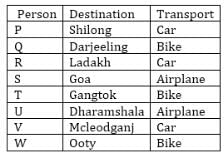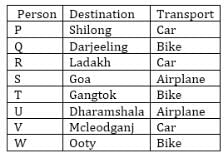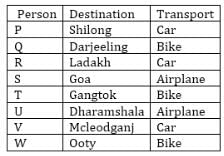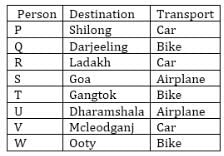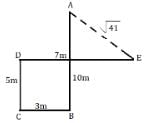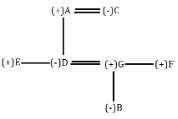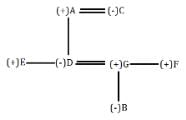NABARD Assistant Manager Grade 'A' Practice Test - 5 - Banking Exams MCQ
30 Questions MCQ Test - NABARD Assistant Manager Grade 'A' Practice Test - 5
Study the information carefully and answer the questions given below.
Seven persons i.e. A, B, C, D, E, F and G are sitting in a row. Some of them faces north and some of them faces south. Each of them has different lucky numbers i.e. 4, 5, 11, 12, 14, 16 and 22. All information is not necessarily in same order. Not more than two adjacent persons face same direction.
G sits one of the extreme ends of row. The person whose lucky number is prime number sits second to the right of G. E sits third to the left of C. B sits third to the right of D. A sits second to left of one whose lucky number is 12. D faces in the same direction as B. The person whose lucky number is 4 sits second to the right of person whose lucky number is 14. Four persons sit between the one whose lucky number is 12 and the one whose lucky number is 22. The person whose lucky number is 16 sits on of the extreme ends of row. Equal number of persons sits to the right and left side of A. B face opposite to the direction of G. The difference between the lucky number of C and B is 6. C does not face south direction. D is not immediate neighbor of A. E and A faces in opposite direction. D is not immediate neighbor of the person whose lucky number is 5. F faces opposite to the direction of D. The person whose lucky number is 14 is not the immediate neighbor of G. A’s lucky number is not 14.
Q. Who among the following person sits second to the left of B?
G sits one of the extreme ends of row. The person whose lucky number is prime number sits second to the right of G. E sits third to the left of C. B sits third to the right of D. A sits second to left of one whose lucky number is 12. D faces in the same direction as B. The person whose lucky number is 4 sits second to the right of person whose lucky number is 14. Four persons sit between the one whose lucky number is 12 and the one whose lucky number is 22. The person whose lucky number is 16 sits on of the extreme ends of row. Equal number of persons sits to the right and left side of A. B face opposite to the direction of G. The difference between the lucky number of C and B is 6. C does not face south direction. D is not immediate neighbor of A. E and A faces in opposite direction. D is not immediate neighbor of the person whose lucky number is 5. F faces opposite to the direction of D. The person whose lucky number is 14 is not the immediate neighbor of G. A’s lucky number is not 14.
Study the information carefully and answer the questions given below.
Seven persons i.e. A, B, C, D, E, F and G are sitting in a row. Some of them faces north and some of them faces south. Each of them has different lucky numbers i.e. 4, 5, 11, 12, 14, 16 and 22. All information is not necessarily in same order. Not more than two adjacent persons face same direction.
G sits one of the extreme ends of row. The person whose lucky number is prime number sits second to the right of G. E sits third to the left of C. B sits third to the right of D. A sits second to left of one whose lucky number is 12. D faces in the same direction as B. The person whose lucky number is 4 sits second to the right of person whose lucky number is 14. Four persons sit between the one whose lucky number is 12 and the one whose lucky number is 22. The person whose lucky number is 16 sits on of the extreme ends of row. Equal number of persons sits to the right and left side of A. B face opposite to the direction of G. The difference between the lucky number of C and B is 6. C does not face south direction. D is not immediate neighbor of A. E and A faces in opposite direction. D is not immediate neighbor of the person whose lucky number is 5. F faces opposite to the direction of D. The person whose lucky number is 14 is not the immediate neighbor of G. A’s lucky number is not 14.
Q. What is the difference between the lucky number of E and G?
G sits one of the extreme ends of row. The person whose lucky number is prime number sits second to the right of G. E sits third to the left of C. B sits third to the right of D. A sits second to left of one whose lucky number is 12. D faces in the same direction as B. The person whose lucky number is 4 sits second to the right of person whose lucky number is 14. Four persons sit between the one whose lucky number is 12 and the one whose lucky number is 22. The person whose lucky number is 16 sits on of the extreme ends of row. Equal number of persons sits to the right and left side of A. B face opposite to the direction of G. The difference between the lucky number of C and B is 6. C does not face south direction. D is not immediate neighbor of A. E and A faces in opposite direction. D is not immediate neighbor of the person whose lucky number is 5. F faces opposite to the direction of D. The person whose lucky number is 14 is not the immediate neighbor of G. A’s lucky number is not 14.
Study the information carefully and answer the questions given below.
Seven persons i.e. A, B, C, D, E, F and G are sitting in a row. Some of them faces north and some of them faces south. Each of them has different lucky numbers i.e. 4, 5, 11, 12, 14, 16 and 22. All information is not necessarily in same order. Not more than two adjacent persons face same direction.
G sits one of the extreme ends of row. The person whose lucky number is prime number sits second to the right of G. E sits third to the left of C. B sits third to the right of D. A sits second to left of one whose lucky number is 12. D faces in the same direction as B. The person whose lucky number is 4 sits second to the right of person whose lucky number is 14. Four persons sit between the one whose lucky number is 12 and the one whose lucky number is 22. The person whose lucky number is 16 sits on of the extreme ends of row. Equal number of persons sits to the right and left side of A. B face opposite to the direction of G. The difference between the lucky number of C and B is 6. C does not face south direction. D is not immediate neighbor of A. E and A faces in opposite direction. D is not immediate neighbor of the person whose lucky number is 5. F faces opposite to the direction of D. The person whose lucky number is 14 is not the immediate neighbor of G. A’s lucky number is not 14.
Q. How many persons sit between E and F?
G sits one of the extreme ends of row. The person whose lucky number is prime number sits second to the right of G. E sits third to the left of C. B sits third to the right of D. A sits second to left of one whose lucky number is 12. D faces in the same direction as B. The person whose lucky number is 4 sits second to the right of person whose lucky number is 14. Four persons sit between the one whose lucky number is 12 and the one whose lucky number is 22. The person whose lucky number is 16 sits on of the extreme ends of row. Equal number of persons sits to the right and left side of A. B face opposite to the direction of G. The difference between the lucky number of C and B is 6. C does not face south direction. D is not immediate neighbor of A. E and A faces in opposite direction. D is not immediate neighbor of the person whose lucky number is 5. F faces opposite to the direction of D. The person whose lucky number is 14 is not the immediate neighbor of G. A’s lucky number is not 14.
Study the information carefully and answer the questions given below.
Seven persons i.e. A, B, C, D, E, F and G are sitting in a row. Some of them faces north and some of them faces south. Each of them has different lucky numbers i.e. 4, 5, 11, 12, 14, 16 and 22. All information is not necessarily in same order. Not more than two adjacent persons face same direction.
G sits one of the extreme ends of row. The person whose lucky number is prime number sits second to the right of G. E sits third to the left of C. B sits third to the right of D. A sits second to left of one whose lucky number is 12. D faces in the same direction as B. The person whose lucky number is 4 sits second to the right of person whose lucky number is 14. Four persons sit between the one whose lucky number is 12 and the one whose lucky number is 22. The person whose lucky number is 16 sits on of the extreme ends of row. Equal number of persons sits to the right and left side of A. B face opposite to the direction of G. The difference between the lucky number of C and B is 6. C does not face south direction. D is not immediate neighbor of A. E and A faces in opposite direction. D is not immediate neighbor of the person whose lucky number is 5. F faces opposite to the direction of D. The person whose lucky number is 14 is not the immediate neighbor of G. A’s lucky number is not 14.
Q. Four of the following five are alike in certain way based from a group, find the one that does not belong to that group?
Study the information carefully and answer the questions given below.
Seven persons i.e. A, B, C, D, E, F and G are sitting in a row. Some of them faces north and some of them faces south. Each of them has different lucky numbers i.e. 4, 5, 11, 12, 14, 16 and 22. All information is not necessarily in same order. Not more than two adjacent persons face same direction.
G sits one of the extreme ends of row. The person whose lucky number is prime number sits second to the right of G. E sits third to the left of C. B sits third to the right of D. A sits second to left of one whose lucky number is 12. D faces in the same direction as B. The person whose lucky number is 4 sits second to the right of person whose lucky number is 14. Four persons sit between the one whose lucky number is 12 and the one whose lucky number is 22. The person whose lucky number is 16 sits on of the extreme ends of row. Equal number of persons sits to the right and left side of A. B face opposite to the direction of G. The difference between the lucky number of C and B is 6. C does not face south direction. D is not immediate neighbor of A. E and A faces in opposite direction. D is not immediate neighbor of the person whose lucky number is 5. F faces opposite to the direction of D. The person whose lucky number is 14 is not the immediate neighbor of G. A’s lucky number is not 14.
Q. Who among the following person sits second to the right of G?
Study the following information carefully to answer the given questions.
A word and number arrangement machine when given an input line of words and numbers
rearranges them following a particular rule in each step. The following is an illustration of input and rearrangement.
Input: 54 Way 14 other 17 11 Classroom 24 Badges Attack
Step I: Attack 54 Way 14 Other 17 Classroom 24 Badges 11
Step II: Attack Classroom 54 Way Other 17 24 Badges 11 14
Step III: Attack Classroom Other 54 Way 17 Badges 11 14 24
Step IV: Attack Classroom Other Badges 54 Way 11 14 24 17
Step V: Attack Classroom Other Badges Way 11 14 24 17 54
And step V is the last step of the above input, as per the rules followed in the steps given above, find out in each of the following questions the appropriate step for the given input.
Input: 41 12 Know 52 Platform 54 Off 35 Focus On
Q. What will be the position of ‘Platform’ with respect to ‘Focus’ in the step III of the input?
Study the following information carefully to answer the given questions.
A word and number arrangement machine when given an input line of words and numbers
rearranges them following a particular rule in each step. The following is an illustration of input and rearrangement.
Input: 54 Way 14 other 17 11 Classroom 24 Badges Attack
Step I: Attack 54 Way 14 Other 17 Classroom 24 Badges 11
Step II: Attack Classroom 54 Way Other 17 24 Badges 11 14
Step III: Attack Classroom Other 54 Way 17 Badges 11 14 24
Step IV: Attack Classroom Other Badges 54 Way 11 14 24 17
Step V: Attack Classroom Other Badges Way 11 14 24 17 54
And step V is the last step of the above input, as per the rules followed in the steps given above, find out in each of the following questions the appropriate step for the given input.
Input: 41 12 Know 52 Platform 54 Off 35 Focus On
Q. What will be the position of ‘54’ in the last but one step?
Study the following information carefully to answer the given questions.
A word and number arrangement machine when given an input line of words and numbers
rearranges them following a particular rule in each step. The following is an illustration of input and rearrangement.
Input: 54 Way 14 other 17 11 Classroom 24 Badges Attack
Step I: Attack 54 Way 14 Other 17 Classroom 24 Badges 11
Step II: Attack Classroom 54 Way Other 17 24 Badges 11 14
Step III: Attack Classroom Other 54 Way 17 Badges 11 14 24
Step IV: Attack Classroom Other Badges 54 Way 11 14 24 17
Step V: Attack Classroom Other Badges Way 11 14 24 17 54
And step V is the last step of the above input, as per the rules followed in the steps given above, find out in each of the following questions the appropriate step for the given input.
Input: 41 12 Know 52 Platform 54 Off 35 Focus On
Q. Which of the following will be the penultimate step?
Study the following information carefully to answer the given questions.
A word and number arrangement machine when given an input line of words and numbers
rearranges them following a particular rule in each step. The following is an illustration of input and rearrangement.
Input: 54 Way 14 other 17 11 Classroom 24 Badges Attack
Step I: Attack 54 Way 14 Other 17 Classroom 24 Badges 11
Step II: Attack Classroom 54 Way Other 17 24 Badges 11 14
Step III: Attack Classroom Other 54 Way 17 Badges 11 14 24
Step IV: Attack Classroom Other Badges 54 Way 11 14 24 17
Step V: Attack Classroom Other Badges Way 11 14 24 17 54
And step V is the last step of the above input, as per the rules followed in the steps given above, find out in each of the following questions the appropriate step for the given input.
Input: 41 12 Know 52 Platform 54 Off 35 Focus On
Q. Which of the following will be step IV of the above input?
Study the following information carefully to answer the given questions.
A word and number arrangement machine when given an input line of words and numbers
rearranges them following a particular rule in each step. The following is an illustration of input and rearrangement.
Input: 54 Way 14 other 17 11 Classroom 24 Badges Attack
Step I: Attack 54 Way 14 Other 17 Classroom 24 Badges 11
Step II: Attack Classroom 54 Way Other 17 24 Badges 11 14
Step III: Attack Classroom Other 54 Way 17 Badges 11 14 24
Step IV: Attack Classroom Other Badges 54 Way 11 14 24 17
Step V: Attack Classroom Other Badges Way 11 14 24 17 54
And step V is the last step of the above input, as per the rules followed in the steps given above, find out in each of the following questions the appropriate step for the given input.
Input: 41 12 Know 52 Platform 54 Off 35 Focus On
Q. What will be the position of ‘35’ in step III?
Study the information carefully and answer the questions given below.
Eight persons namely P, Q, R, S, T, U, V and W go to eight different destinations for holidays i.e. Shillong, Ooty, Ladakh, Goa, Gangtok, Darjeeling, Mcleodganj and Dharamshala. They are going through three means of transport i.e. Bike, Car, Airplane. Atleast two persons and Not more than three persons use same means of transport. All information is not necessarily in same order.
U goes by Airplane. R goes to Ladakh and does not go by airplane. Only one person uses same means of transport with the person who goes Dharamshala. Q and the person who goes Gangtok use same means of transport. W goes to Ooty and does not go by airplane. The person who goes Darjeeling and the person who goes Ooty use the same means of transport. P goes to Shillong and does not go by bike or airplane. R and the person who goes Mcleodganj use the same means of transport. T goes by bike. Q goes Darjeeling and does not go by airplane or car. V does not go by airplane. U does not go to Goa.
Q. On Which of the following destination S goes?
Study the information carefully and answer the questions given below.
Eight persons namely P, Q, R, S, T, U, V and W go to eight different destinations for holidays i.e. Shillong, Ooty, Ladakh, Goa, Gangtok, Darjeeling, Mcleodganj and Dharamshala. They are going through three means of transport i.e. Bike, Car, Airplane. Atleast two persons and Not more than three persons use same means of transport. All information is not necessarily in same order.
U goes by Airplane. R goes to Ladakh and does not go by airplane. Only one person uses same means of transport with the person who goes Dharamshala. Q and the person who goes Gangtok use same means of transport. W goes to Ooty and does not go by airplane. The person who goes Darjeeling and the person who goes Ooty use the same means of transport. P goes to Shillong and does not go by bike or airplane. R and the person who goes Mcleodganj use the same means of transport. T goes by bike. Q goes Darjeeling and does not go by airplane or car. V does not go by airplane. U does not go to Goa.
Q. Which of the following group of persons go by bike?
Study the information carefully and answer the questions given below.
Eight persons namely P, Q, R, S, T, U, V and W go to eight different destinations for holidays i.e. Shillong, Ooty, Ladakh, Goa, Gangtok, Darjeeling, Mcleodganj and Dharamshala. They are going through three means of transport i.e. Bike, Car, Airplane. Atleast two persons and Not more than three persons use same means of transport. All information is not necessarily in same order.
U goes by Airplane. R goes to Ladakh and does not go by airplane. Only one person uses same means of transport with the person who goes Dharamshala. Q and the person who goes Gangtok use same means of transport. W goes to Ooty and does not go by airplane. The person who goes Darjeeling and the person who goes Ooty use the same means of transport. P goes to Shillong and does not go by bike or airplane. R and the person who goes Mcleodganj use the same means of transport. T goes by bike. Q goes Darjeeling and does not go by airplane or car. V does not go by airplane. U does not go to Goa.
Q. Which of following combination is true?
Study the information carefully and answer the questions given below.
Eight persons namely P, Q, R, S, T, U, V and W go to eight different destinations for holidays i.e. Shillong, Ooty, Ladakh, Goa, Gangtok, Darjeeling, Mcleodganj and Dharamshala. They are going through three means of transport i.e. Bike, Car, Airplane. Atleast two persons and Not more than three persons use same means of transport. All information is not necessarily in same order.
U goes by Airplane. R goes to Ladakh and does not go by airplane. Only one person uses same means of transport with the person who goes Dharamshala. Q and the person who goes Gangtok use same means of transport. W goes to Ooty and does not go by airplane. The person who goes Darjeeling and the person who goes Ooty use the same means of transport. P goes to Shillong and does not go by bike or airplane. R and the person who goes Mcleodganj use the same means of transport. T goes by bike. Q goes Darjeeling and does not go by airplane or car. V does not go by airplane. U does not go to Goa.
Q. The person who goes to Goa uses which means of transport?
Study the information carefully and answer the questions given below.
Eight persons namely P, Q, R, S, T, U, V and W go to eight different destinations for holidays i.e. Shillong, Ooty, Ladakh, Goa, Gangtok, Darjeeling, Mcleodganj and Dharamshala. They are going through three means of transport i.e. Bike, Car, Airplane. Atleast two persons and Not more than three persons use same means of transport. All information is not necessarily in same order.
U goes by Airplane. R goes to Ladakh and does not go by airplane. Only one person uses same means of transport with the person who goes Dharamshala. Q and the person who goes Gangtok use same means of transport. W goes to Ooty and does not go by airplane. The person who goes Darjeeling and the person who goes Ooty use the same means of transport. P goes to Shillong and does not go by bike or airplane. R and the person who goes Mcleodganj use the same means of transport. T goes by bike. Q goes Darjeeling and does not go by airplane or car. V does not go by airplane. U does not go to Goa.
Q. Which among the following person goes Dharamshala?
Study the information carefully and answer the questions given below.
Mohit starts his journey from point A. He walks 10m in South direction and reaches at point B. Now he turns to the right, he walks 3m to reach point C then he takes right turn and walk 5m to reach point D. From point D, he walks 7m in east direction and reaches at point E.
Q. What is the shortest distance between A and E?
Study the information carefully and answer the questions given below.
Mohit starts his journey from point A. He walks 10m in South direction and reaches at point B. Now he turns to the right, he walks 3m to reach point C then he takes right turn and walk 5m to reach point D. From point D, he walks 7m in east direction and reaches at point E.
Q. In which direction point D with respect to point A?
Study the information carefully and answer the questions given below.
A, B, C, D, E, F, and G are 7 family members among them only 3 are females. A is married to C. A has one son and one daughter. G is brother in law of E. A is the grandfather of B. F is the brother of G. E is the brother of D and B is niece of E.
Q. How is D related to A?
Study the information carefully and answer the questions given below.
A, B, C, D, E, F, and G are 7 family members among them only 3 are females. A is married to C. A has one son and one daughter. G is brother in law of E. A is the grandfather of B. F is the brother of G. E is the brother of D and B is niece of E.
Q. How is D related to F?
Study the information carefully and answer the questions given below.
A, B, C, D, E, F, and G are 7 family members among them only 3 are females. A is married to C. A has one son and one daughter. G is brother in law of E. A is the grandfather of B. F is the brother of G. E is the brother of D and B is niece of E.
Q. If H is a daughter of E then how is H related to B?
Bar-graph shows the quantities of 5 different products sold by a shopkeeper and table shows the price per unit (in thousand) of all 5 products.
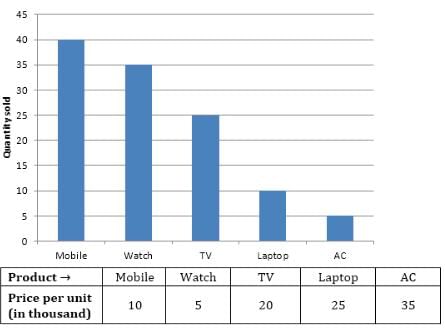
Q. What is the difference of cost of all mobiles to cost of all watches sold by the shopkeeper?
Bar-graph shows the quantities of 5 different products sold by a shopkeeper and table shows the price per unit (in thousand) of all 5 products.

Q. Total cost of all TV sold is approximately what percent more or less than total cost of all AC sold by the shopkeeper?
Bar-graph shows the quantities of 5 different products sold by a shopkeeper and table shows the price per unit (in thousand) of all 5 products.

Q. If 20% of watch sold is defective then find the average of cost of watches which are not defective and cost of all Laptop (in Rs)?
Bar-graph shows the quantities of 5 different products sold by a shopkeeper and table shows the price per unit (in thousand) of all 5 products.

Q. What is the ratio of cost of half of the number of mobiles sold to cost of all AC sold?
Bar-graph shows the quantities of 5 different products sold by a shopkeeper and table shows the price per unit (in thousand) of all 5 products.

Q. If another product named X is sold by the shopkeeper whose price is average of price of a watch and a laptop and total cost of all quantities of X is Rs 75 thousand. Then find the number of quantity sold by shopkeeper of product X.
What comes at the place of questions marks regarding given pattern of series
42, 66, ? , 186, 282, 402
What comes at the place of questions marks regarding given pattern of series
45, 59, 91, ? , 241, 375
What comes at the place of questions marks regarding given pattern of series
64, ? , 240, 840, 3780, 20790
What comes at the place of questions marks regarding given pattern of series
64, 128, 32, ? , 16, 32
What comes at the place of questions marks regarding given pattern of series
525, 561, ? , 725, 869, 1065








